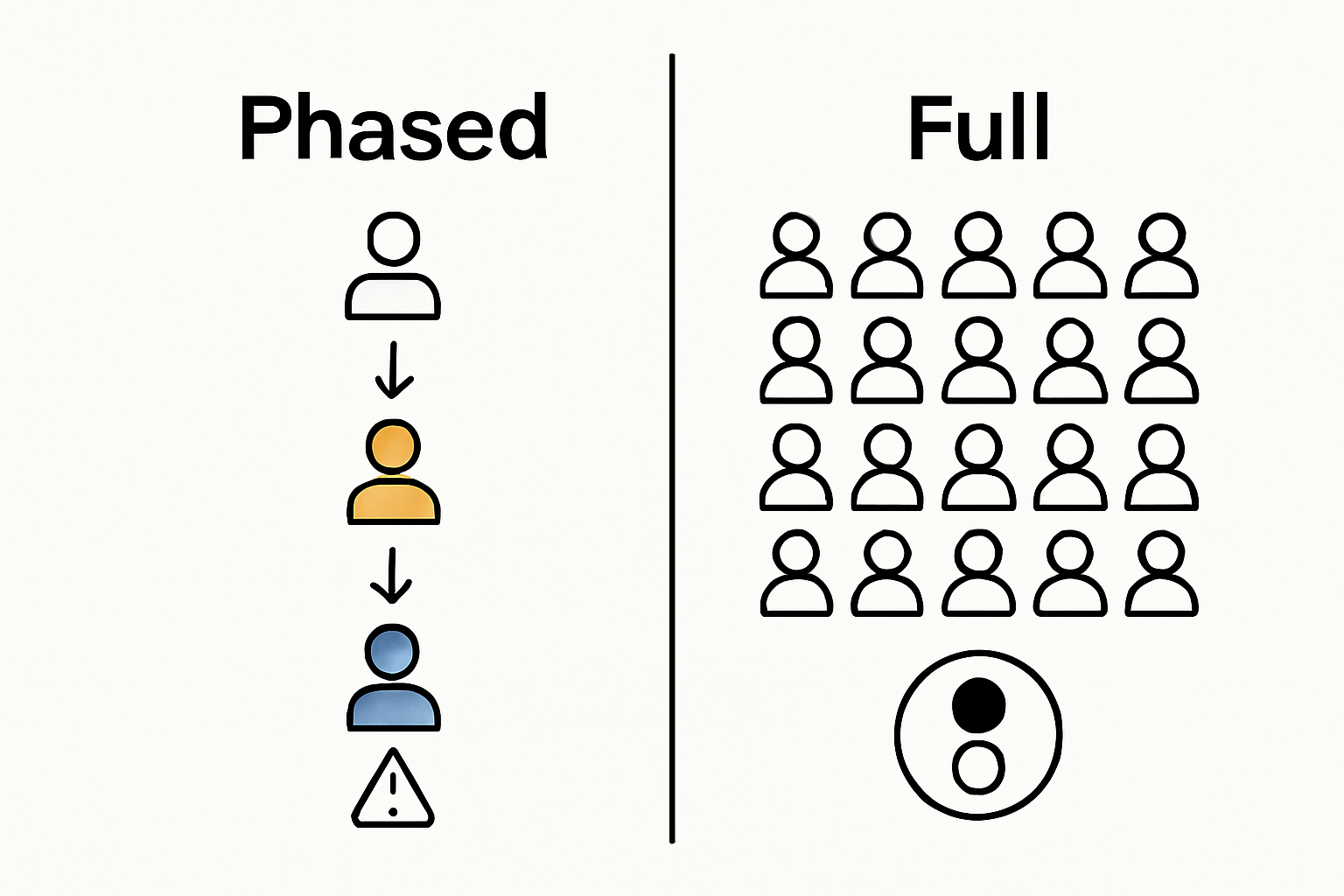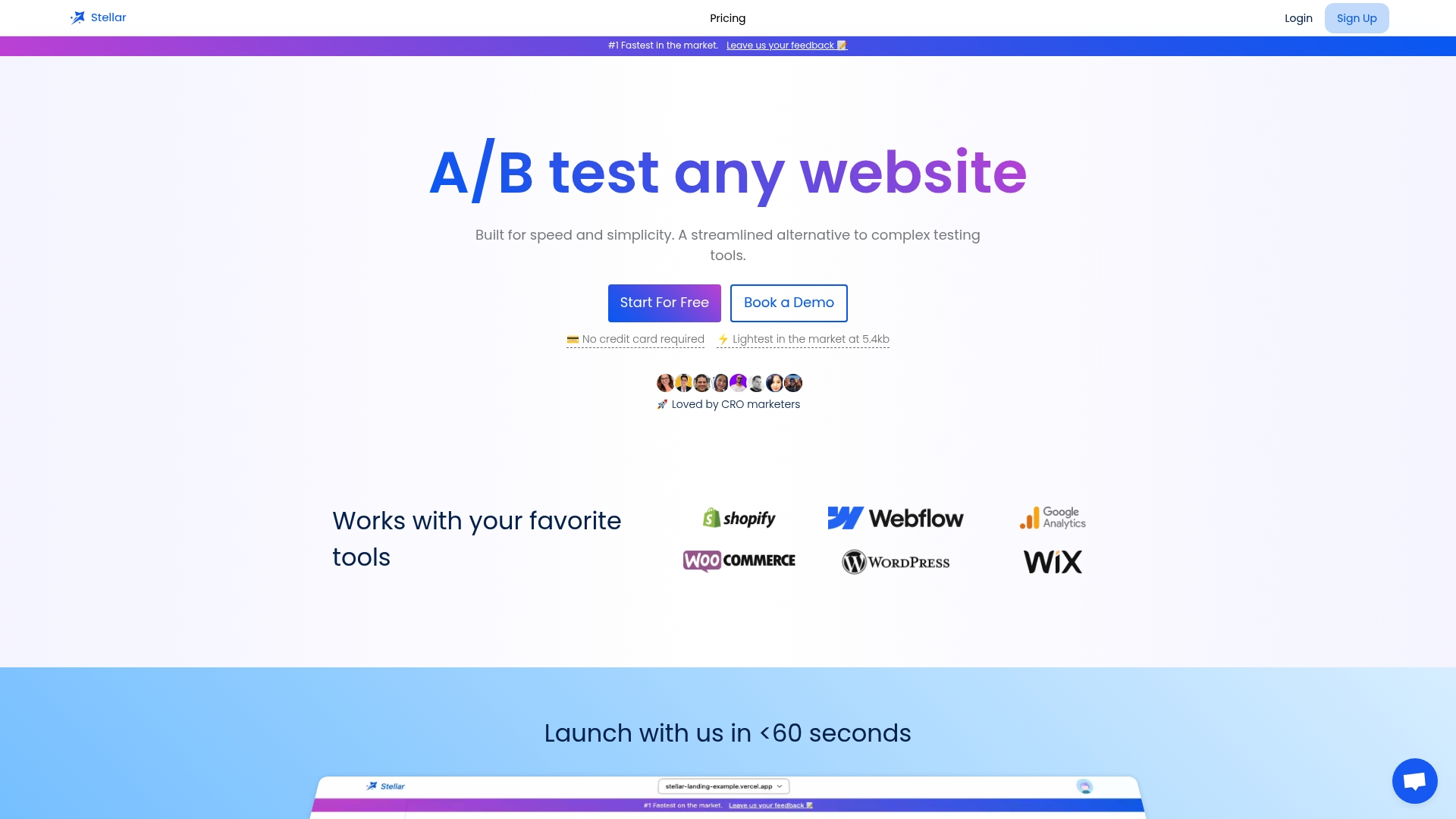
Understanding Best Practices for Test Rollout

Rolling out new software or tech features can feel risky. Studies show phased rollouts cut negative impacts by up to 75 percent compared to all-at-once launches. Think that means fewer headaches are the only reason teams bother with test rollouts. Actually, it is the granular feedback and learning you get during a test rollout that unlocks smarter decisions and stronger end results every time.
Table of Contents
- What Are Test Rollouts And Their Importance?
- Key Principles Behind Effective Test Rollout
- The Role Of Data Analysis In Test Rollouts
- Common Challenges And Solutions In Test Rollouts
- Real-World Examples Of Successful Test Rollouts
Quick Summary
| Takeaway | Explanation |
|---|---|
| Test rollouts minimize risks | By gradually introducing changes, organizations can identify potential issues before widespread use, reducing negative impacts. |
| Strategic user segmentation is essential | Selecting specific user groups for testing helps gather focused feedback and improve implementation effectiveness. |
| Continuous monitoring drives improvement | Real-time performance metrics allow for prompt adjustments, enhancing user experience and system reliability. |
| Data analysis informs decision-making | Effective data collection and interpretation transform insights into actionable strategies for product enhancements. |
| Address user resistance proactively | Understanding human factors like skills gaps and cognitive resistance helps ease transitions during technology adoption. |
What Are Test Rollouts and Their Importance?
Test rollouts represent a strategic approach to systematically introducing new software, features, products, or processes within an organization or digital environment. By implementing controlled deployment methods, teams can minimize potential risks and gather critical insights before full-scale implementation.
Understanding the Core Concept
At its fundamental level, a test rollout involves gradually introducing a new solution to a limited subset of users, systems, or environments. This methodical process allows organizations to observe performance, collect real-world feedback, and identify potential issues before widespread adoption. Unlike traditional deployment strategies, test rollouts create a controlled experimental environment where potential challenges can be detected and addressed proactively.
Read our comprehensive guide on scaling A/B testing efforts to understand how strategic rollouts can transform your product development approach.
Significance in Digital Transformation
Test rollouts play a critical role in digital transformation strategies. According to research from educational technology assessments, systematic rollout approaches provide organizations with several key advantages:
- Risk Mitigation: Reduce potential negative impacts of new implementations
- Performance Validation: Confirm system functionality under real-world conditions
- User Experience Optimization: Gather granular insights about user interactions and potential friction points
By embracing a nuanced, phased approach, businesses can dramatically improve their chances of successful innovation while maintaining operational stability and minimizing potential disruptions.
The strategic importance of test rollouts cannot be overstated. They serve as a critical bridge between theoretical product design and practical, user-centered implementation, allowing organizations to make data-driven decisions that enhance overall performance and user satisfaction.
Key Principles Behind Effective Test Rollout
Effective test rollouts are not just about launching a new feature or process but about implementing a strategic, methodical approach that minimizes risks and maximizes insights. The principles underpinning successful test rollouts transcend simple technical deployment and encompass broader organizational strategies.
Strategic Segmentation and Controlled Exposure
The cornerstone of a successful test rollout is strategic user segmentation. This involves carefully selecting a representative subset of users who will experience the new implementation. By targeting specific user groups, organizations can gather nuanced feedback and observe real-world interactions without exposing the entire user base to potential disruptions.

Learn about fast website testing strategies that drive results to understand how precise segmentation can transform your rollout approach.
Comprehensive Monitoring and Adaptive Response
A robust test rollout requires continuous, granular monitoring that goes beyond surface-level metrics. According to performance engineering research, effective monitoring should encompass multiple dimensions:
- Performance Metrics: Track system response times, resource utilization, and potential bottlenecks
- User Experience Indicators: Measure user engagement, satisfaction rates, and interaction patterns
- Error and Anomaly Detection: Identify and log unexpected behaviors or system inconsistencies
The key is not just collecting data but developing a responsive mechanism that allows for immediate adjustments based on real-time insights.
Iterative Learning and Incremental Scaling
Test rollouts are fundamentally about creating a learning environment. Incremental scaling ensures that organizations can progressively expand their implementation while maintaining tight control over potential risks. This approach transforms test rollouts from a mere technical process into a strategic organizational learning mechanism, where each phase provides valuable insights that inform subsequent deployment stages.
The Role of Data Analysis in Test Rollouts
Data analysis serves as the critical foundation that transforms test rollouts from subjective experiments into strategic, evidence-based decision-making processes. By systematically collecting, interpreting, and leveraging data insights, organizations can convert raw information into actionable intelligence that drives meaningful improvements.
Comprehensive Data Collection Strategies
Effective data analysis begins with a robust collection framework that captures multidimensional insights. This involves establishing comprehensive measurement protocols that go beyond surface-level metrics. Organizations must design data collection mechanisms that capture quantitative performance indicators as well as qualitative user experience elements.
Explore our guide on analytics dashboards for understanding test data to deepen your understanding of strategic data interpretation.
Interpreting Complex Analytical Signals
According to pilot testing research from RAND Corporation, successful data analysis in test rollouts requires sophisticated interpretation techniques that can:
- Identify Subtle Patterns: Detect nuanced trends that might not be immediately apparent
- Contextualize Metrics: Understand performance indicators within broader organizational goals
- Predict Potential Outcomes: Use predictive modeling to anticipate future implementation challenges
The goal is not merely to collect data but to transform raw information into meaningful strategic insights that guide future decision-making.
Translating Insights into Actionable Strategies
Data analysis in test rollouts transcends traditional reporting. Intelligent analysis means creating a dynamic feedback loop where each data point becomes a catalyst for continuous improvement. By developing adaptive interpretation frameworks, organizations can rapidly respond to emerging trends, mitigate potential risks, and optimize their implementation strategies in real time.
Common Challenges and Solutions in Test Rollouts
Test rollouts inherently involve complex technological and organizational dynamics that can create significant obstacles. Understanding these challenges and developing strategic solutions is crucial for successful implementation of new features, processes, or systems.
Performance and Scalability Limitations
Performance bottlenecks represent one of the most critical challenges in test rollouts. Organizations frequently encounter unexpected system strain when introducing new implementations. These limitations can manifest through increased response times, resource consumption, and potential system instability.
Learn how to test without performance bloat to optimize your rollout strategies and minimize potential technical complications.
User Adoption and Resistance Dynamics
According to organizational change management research, successful test rollouts must address inherent human factors that can impede technological transitions. Key challenges include:
- Cognitive Resistance: Users' psychological barriers to accepting new systems or processes
- Skills Gap: Potential misalignment between existing user capabilities and new technology requirements
- Cultural Inertia: Organizational cultural elements that resist technological transformation
Mitigating these challenges requires a nuanced approach that combines technical implementation with comprehensive change management strategies.
Complexity Management and Risk Mitigation
Effective test rollouts demand sophisticated risk management techniques. This involves creating flexible implementation frameworks that can adapt rapidly to emerging challenges. The goal is not to eliminate all potential risks but to develop resilient systems capable of absorbing and responding to unexpected complications quickly and efficiently. By anticipating potential failure points and developing contingency protocols, organizations can transform potential obstacles into opportunities for continuous improvement and learning.
The following table summarizes the most common challenges mentioned in test rollouts and the corresponding solutions highlighted in the article.
| Challenge | Description | Solution Approach |
|---|---|---|
| Performance Limitations | Unexpected system strain or bottlenecks during new implementations | Optimize rollout strategies and monitor key metrics |
| Scalability Issues | Increased response times, resource usage, and instability | Incremental scaling with adaptive frameworks |
| User Adoption Resistance | Psychological barriers and reluctance to embrace new systems | Comprehensive change management and communication |
| Skills Gap | Mismatch between user abilities and new technology requirements | Targeted training and support programs |
| Cultural Inertia | Organizational culture resisting technological transformation | Align rollouts with cultural change initiatives |
| Complexity and Risk Management | Difficulty adapting to unforeseen complications during rollout | Flexible, resilient implementation frameworks |
Real-World Examples of Successful Test Rollouts
Real-world test rollouts demonstrate the critical importance of strategic, methodical implementation across various technological and organizational contexts. These practical examples illustrate how thoughtful approaches can transform potential risks into opportunities for significant improvement and innovation.
Technology Sector Deployment Strategies
Digital transformation initiatives frequently leverage sophisticated test rollout methodologies to minimize potential disruptions. Companies like Google and Microsoft have long employed incremental deployment strategies that allow for comprehensive performance evaluation before full-scale implementation. These approaches involve carefully segmented user groups, extensive monitoring protocols, and adaptive feedback mechanisms.
Explore strategies for fast testing and rapid results to understand how leading organizations optimize their rollout processes.
Educational Technology Implementation
According to large-scale educational technology research, successful test rollouts in academic environments demonstrate remarkable insights into systematic implementation. Key characteristics of effective educational technology deployments include:
- Phased User Introduction: Gradual implementation across different school districts
- Comprehensive Performance Tracking: Detailed monitoring of learning outcomes
- Continuous Feedback Integration: Rapid adaptation based on user experiences
These approaches allow educational institutions to validate technological interventions while minimizing potential disruptions to learning environments.
Enterprise Software Transformation
Complex organizational systems require nuanced test rollout strategies that balance technological innovation with operational stability. Successful enterprises develop multilayered implementation frameworks that allow for granular control, real-time monitoring, and rapid response to emerging challenges. By treating test rollouts as dynamic, iterative processes rather than static deployment events, organizations can create more resilient and adaptable technological ecosystems.

Ready to Master Risk-Free Test Rollouts?
Struggling with the uncertainty of new feature launches and the fear of performance dips? You read about the importance of controlled test rollouts—but friction, slow results, and technical complexity can set you back. Many marketers want safer experimentation, yet dread cumbersome tools and unclear data. Imagine confidently deploying features, gathering live feedback, and making data-driven decisions fast.

Discover how Stellar makes best practices for test rollouts easy. With our lightweight A/B testing platform, even non-technical teams can quickly launch tests using the no-code visual editor. Enjoy real-time analytics and advanced goal tracking for instant insights, minimizing risk and guesswork. Ready to stop worrying and start winning? Get started today with Stellar and see how quickly your rollouts improve. Don’t let another rollout cause chaos—take control now.
Frequently Asked Questions
What is a test rollout?
A test rollout is a strategic approach that involves introducing new software, features, or processes gradually to a limited set of users or environments to gather feedback and minimize risks before full-scale implementation.
Why are test rollouts important for organizations?
Test rollouts help organizations mitigate risks, validate performance under real-world conditions, and optimize user experience by identifying potential issues before widespread adoption.
What are the key principles for an effective test rollout?
Effective test rollouts involve strategic user segmentation, comprehensive monitoring of performance and user experience, and an iterative learning approach that allows organizations to make data-driven decisions throughout the process.
How can data analysis enhance the test rollout process?
Data analysis transforms test rollouts from mere experiments into strategic decision-making tools by providing insights from collected data, helping organizations identify patterns, contextualize metrics, and adapt strategies in real time.
Recommended
Published: 9/28/2025